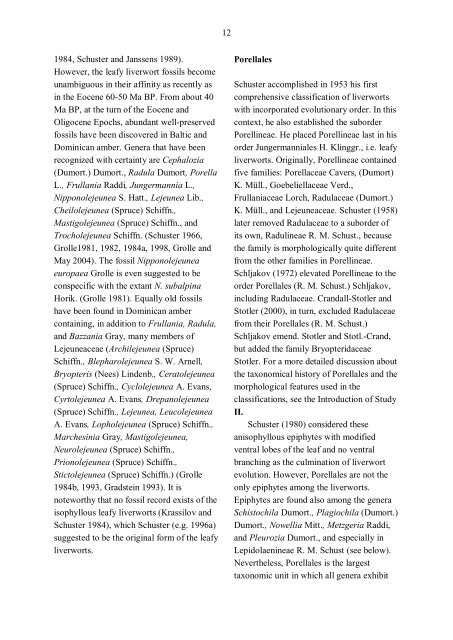Evolutionary relationships of liverworts with a special focus ... - Doria
Evolutionary relationships of liverworts with a special focus ... - Doria
Evolutionary relationships of liverworts with a special focus ... - Doria
Create successful ePaper yourself
Turn your PDF publications into a flip-book with our unique Google optimized e-Paper software.
12<br />
1984, Schuster and Janssens 1989).<br />
However, the leafy liverwort fossils become<br />
unambiguous in their affinity as recently as<br />
in the Eocene 60-50 Ma BP. From about 40<br />
Ma BP, at the turn <strong>of</strong> the Eocene and<br />
Oligocene Epochs, abundant well-preserved<br />
fossils have been discovered in Baltic and<br />
Dominican amber. Genera that have been<br />
recognized <strong>with</strong> certainty are Cephalozia<br />
(Dumort.) Dumort., Radula Dumort, Porella<br />
L., Frullania Raddi, Jungermannia L.,<br />
Nipponolejeunea S. Hatt., Lejeunea Lib.,<br />
Cheilolejeunea (Spruce) Schiffn.,<br />
Mastigolejeunea (Spruce) Schiffn., and<br />
Trocholejeunea Schiffn. (Schuster 1966,<br />
Grolle1981, 1982, 1984a, 1998, Grolle and<br />
May 2004). The fossil Nipponolejeunea<br />
europaea Grolle is even suggested to be<br />
conspecific <strong>with</strong> the extant N. subalpina<br />
Horik. (Grolle 1981). Equally old fossils<br />
have been found in Dominican amber<br />
containing, in addition to Frullania, Radula,<br />
and Bazzania Gray, many members <strong>of</strong><br />
Lejeuneaceae (Archilejeunea (Spruce)<br />
Schiffn., Blepharolejeunea S. W. Arnell,<br />
Bryopteris (Nees) Lindenb., Ceratolejeunea<br />
(Spruce) Schiffn., Cyclolejeunea A. Evans,<br />
Cyrtolejeunea A. Evans, Drepanolejeunea<br />
(Spruce) Schiffn., Lejeunea, Leucolejeunea<br />
A. Evans, Lopholejeunea (Spruce) Schiffn.,<br />
Marchesinia Gray, Mastigolejeunea,<br />
Neurolejeunea (Spruce) Schiffn.,<br />
Prionolejeunea (Spruce) Schiffn.,<br />
Stictolejeunea (Spruce) Schiffn.) (Grolle<br />
1984b, 1993, Gradstein 1993). It is<br />
noteworthy that no fossil record exists <strong>of</strong> the<br />
isophyllous leafy <strong>liverworts</strong> (Krassilov and<br />
Schuster 1984), which Schuster (e.g. 1996a)<br />
suggested to be the original form <strong>of</strong> the leafy<br />
<strong>liverworts</strong>.<br />
Porellales<br />
Schuster accomplished in 1953 his first<br />
comprehensive classification <strong>of</strong> <strong>liverworts</strong><br />
<strong>with</strong> incorporated evolutionary order. In this<br />
context, he also established the suborder<br />
Porellineae. He placed Porellineae last in his<br />
order Jungermanniales H. Klinggr., i.e. leafy<br />
<strong>liverworts</strong>. Originally, Porellineae contained<br />
five families: Porellaceae Cavers, (Dumort)<br />
K. Müll., Goebeliellaceae Verd.,<br />
Frullaniaceae Lorch, Radulaceae (Dumort.)<br />
K. Müll., and Lejeuneaceae. Schuster (1958)<br />
later removed Radulaceae to a suborder <strong>of</strong><br />
its own, Radulineae R. M. Schust., because<br />
the family is morphologically quite different<br />
from the other families in Porellineae.<br />
Schljakov (1972) elevated Porellineae to the<br />
order Porellales (R. M. Schust.) Schljakov,<br />
including Radulaceae. Crandall-Stotler and<br />
Stotler (2000), in turn, excluded Radulaceae<br />
from their Porellales (R. M. Schust.)<br />
Schljakov emend. Stotler and Stotl.-Crand,<br />
but added the family Bryopteridaceae<br />
Stotler. For a more detailed discussion about<br />
the taxonomical history <strong>of</strong> Porellales and the<br />
morphological features used in the<br />
classifications, see the Introduction <strong>of</strong> Study<br />
II.<br />
Schuster (1980) considered these<br />
anisophyllous epiphytes <strong>with</strong> modified<br />
ventral lobes <strong>of</strong> the leaf and no ventral<br />
branching as the culmination <strong>of</strong> liverwort<br />
evolution. However, Porellales are not the<br />
only epiphytes among the <strong>liverworts</strong>.<br />
Epiphytes are found also among the genera<br />
Schistochila Dumort., Plagiochila (Dumort.)<br />
Dumort., Nowellia Mitt., Metzgeria Raddi,<br />
and Pleurozia Dumort., and e<strong>special</strong>ly in<br />
Lepidolaenineae R. M. Schust (see below).<br />
Nevertheless, Porellales is the largest<br />
taxonomic unit in which all genera exhibit
















